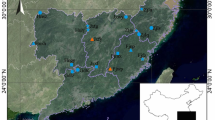Abstract
Prince Rupprecht’s larch (Larix principis-rupprechtii Mayr.), a deciduous conifer, widely grows in middle and high elevations of Northern China. Its natural distribution has sharply decreased and has become fragmented, which may have resulted in the loss of genetic variation. In this study, ten natural populations across the entire range of this species were analyzed using amplified fragment length polymorphism markers. A total of 309 loci were detected from 225 individuals of these populations, of which 261 (84.5%) were polymorphic. At the species level, the genetic diversity was high (average of the Nei’s genetic diversity He = 0.2602, and Shannon’s information index I = 0.3967). The results of molecular variance analysis showed that 90.71% of the genetic diversity occurred within populations. The genetic differentiation among populations was moderate as a whole (FST = 0.0929, GST = 0.1510), which is consistent with the moderate level of gene flow among populations (Nm = 2.8116). Based on the unweighted pair group method with arithmetic mean and STRUCTURE analysis, these populations were grouped into three genetically distinct clusters. The degree of inter-population differentiation (GST = 0.1338) for the south group was larger than that for the north group (GST = 0.0915). There was a significant correlation between genetic distance and geographic distance across the species range (r = 0.316, P < 0.05). Genetic diversity was significantly associated with longitude but not elevation or climatic factors. The populations with high genetic diversity from each cluster are therefore recommended for future conservation and management of this species.



Similar content being viewed by others
References
Aichi-Yousfi H, Bahri BA, Medini M, Rouz S, Nejib Rejeb M, Ghrabi-Gammar Z (2016) Genetic diversity and population structure of six species of Capparis in Tunisia using AFLP markers. CR Biol 339(11–12):442–453
Barchenkov AP (2011) Morphological variability and quality of seeds of Larix gmelinii (Rupr.) Rupr. Contemp Probl Ecol 4(3):327–333
Barrett SCH, Kohn JR (1991) Genetics and evolutionary consequences of small population size in plants: implications for conservation. In: Falk DA, Holsinger KE (eds) Genetics and conservation of rare plants. Oxford University Press, New York, pp 3–30
Binney HA, Willis KJ, Edwards ME, Bhagwat SA, Anderson PM, Andreev AA, Blaauw M, Damblon F, Haesaerts P, Kienast F, Kremenetski KV, Krivonogov SK, Lozhkin AV, Macdonald GM, Novenko EY, Oksanen P, Sapelko TV, Väliranta M, Vazhenina L (2009) The distribution of late Quaternary woody taxa in northern Eurasia: evidence from a new macrofossil database. Quat Sci Rev 28:2445–2464
Borkowski DS, Hoban SM, Chatwin W, Romero-Severson J (2017) Rangewide population differentiation and population substructure in Quercus rubra. Tree Genet Genome 13(3):67
Di XY, Li XN, Wang QX, Wang MB (2014) Genetic diversity of natural populations of Larix principis-rupprechtii in Shanxi Province, China. Biochem Syst Ecol 54:71–77
Dong ML, Wang ZW, He QW, Zhao J, Fan ZR, Zhang JF (2018) Development of EST-SSR markers in Larix principis-rupprechtii Mayr. and evaluation of their polymorphism and cross-species amplification. Trees 32:1559–1571
Editing Group of Tree Species in Northern China (1994) Tree species in northern China. China Forestry Publishing House, Beijing, pp 108–118 (in Chinese with English abstract)
Evanno G, Regnaut S, Goudet J (2005) Detecting the number of clusters of individuals using the software STRUCTURE: a simulation study. Mol Ecol 14:2611–2620
Excoffier L, Laval G, Schneider S (2005) Arlequin ver. 3.0: an integrated software package for population genetics data analysis. Evol Bioinform 1:47–50
Fan YM, Zhang DR, Yu DD, Zhang Y (2014) Genetic Diversity and Population Structure of Larix principis rupprechtii Mayr. Hebei Province. J Plant Genet Resour 15(3):465–471 (in Chinese with English abstract)
Gamache I, Jaramillo-Correa JP, Payette S, Bousquet J (2003) Diverging patterns of mitochondrial and nuclear DNA diversity in subarctic black spruce: imprint of a founder effect associated with postglacial colonization. Mol Ecol 12:891–901
Hu XS, Ennos RA, Wang XS (1999) On evolutionary relationships among three Larix taxa in China: L. gemlinii (Rupr.) Rupr., L. olgensis Henry and L. principis-rupprechtii Mayr. Sci Silvae Sin 35(3):84–96 (in Chinese with English abstract)
Huang WD, Zhao XY, Zhao X, Li YL, Feng J, Su N, Pan CC (2018) Environmental determinants of genetic diversity in Salix gordejevii (Salicaceae) in three Sandy Lands, northern China. Acta Oecol 92:67–74
Kozyrenko MM, Artyukova EV, Shmakov VN, Konstantinov YM, Konstantinov YM (2007) Effect of fluoride pollution on genetic variability of Larix gmelinii (Pinaceae) in East Siberia. J For Res Jpn 12(5):388–392
Leng WF, He HS, Liu HJ (2008a) Response of larch species to climate changes. J Plant Ecol 1(3):203–205
Leng WF, He HS, Bu RC, Dai LM, Hu YM, Wang XG (2008b) Predicting the distributions of suitable habitat for three larch species under climate warming in Northeastern China. For Ecol Manag 254:402–428
Lewandowski A (1997) Genetic relationships between European and Siberian larch, Larix spp. (Pinaceae), studied by allozymes. Is the Polish larch a hybrid between these two species? Plant Syst Evol 204:65–73
Li P, Adams WT (1989) Range-wide patterns of allozyme variation in Douglas-fir (Pseudotsuga menziesii). Can J For Res 19:149–161
Li WR, Qi LW, Han YZ (1992) A study on geographic distribution and population variation law of Larix principis-rupprechtii Mary. Natural forest in Shanxi. Sci Silvae Sin 28(6):493–501 (in Chinese with English abstract)
Li WR, Qi LW, Yao YT, Guo AH (1995) A study of the character variations of the young stand of Larix principis-rupprechtii Mayr. in the provenances of Shanxi Province. J Shanxi Agric Univ 15(4):333–338 (in Chinese with English abstract)
Mosca E, Eckert AJ, Di Pierro EA, Rocchini D, La Porta N, Belletti P, Neale DB (2012) The geographical and environmental determinants of genetic diversity for four alpine conifers of the European Alps. Mol Ecol 21(22):5530–5545
Na DC (2006) Analysis on the genetic diversity of Larix gmelinii provenance by using ISSR markers. For Sci Technol 31(1):1–4 (in Chinese with English abstract)
Noël S, Ouellet M, Galois P, Lapointe FJ (2007) Impact of urban fragmentation on the genetic structure of the eastern red-backed salamander. Conserv Genet 8:599–606
Peng M, Qu LN, Wang QY (2014) Seed-specific identification of Larix gmelinii, Larix olgensis, and Larix principis-rupprechtii using sequence-characterised amplified region markers. Biochem Syst Ecol 55:231–235
Qu LN, Wang QY, Yang CP (2007) Species-specific identification of Larix gmelini, L. olgensis and L. principis-rupprechtii by RAPD markers. Chin Bull Bot 24:498–504 (in Chinese with English abstract)
Rohlf FJ (2000) NTSYS-pc: numerical taxonomy and multivariate analysis system, Ver 2.1. Exeter Software, Setauket, New York
Semerikov VL, Lascoux M (1999) Genetic relationship among Eurasian and American Larix species based on allozymes. Heredity 83:62–70
Semerikov VL, Lascoux M (2003) Nuclear and cytoplasmic variation within and between Eurasian Larix, (Pinaceae) species. Am J Bot 90(8):1113–1123
Semerikov VL, Polezhaeva MA (2007) Mitochondrial DNA variation pattern in larches of Eastern Siberia and the Far East. Russ J Genet 43(6):646–652
Sun WT, Yu DD, Dong ML, Zhao J, Wang XP, Zhang HJ, Zhang JF (2017) Evaluation of efficiency of controlled pollination based parentage analysis in a Larix gmelinii var. principis-rupprechtii Mayr. Seed orchard. PLoS ONE 12(4):0176483
Vos P, Hogers R, Bleeker M, Reijans M, van de Lee T, Hornes M, Frijters A, Pot J, Peleman J, Kuiper M, Zabeau M (1995) AFLP: a new technique for DNA fingerprinting. Nucleic Acids Res 23(21):4407–4414
Wang MB, Hao ZZ (2010) Rangewide genetic diversity in natural populations of Chinese Pine (Pinus tabulaeformis). Biochem Genet 48:590–602
Wang QX, Wang MB (2012) Genetic variation in natural populations of Prince Rupprecht’s larch (Larix principis-rupprechtii) with elevation in the Guandi Mountain, China. In: 2012 international conference on biomedical engineering and biotechnology 2012, pp 321–324
Wang GX, Liu XQ, Qiao J (1992) Forest of Shanxi. China Forestry Press, Beijing, pp 108–118 (in Chinese)
Wellenreuther M, Sánchez-Guillén RA, Cordero-Rivera A, Svensson EI, Hansson B (2011) Environmental and climatic determinants of molecular diversity and genetic population structure in a coenagrionid damselfly. PLoS ONE 6(5):153–161
Zhang SG, Xue JJ, Zhang CF (1998) Research on isozymes of two colonies of larix principis-rupprechtii. Seed 5:32–34 (in Chinese with English abstract)
Zhang XB, Feng JH, Ren JR (2001) Morphological variance and natural types’ division of plus trees of Larix principis-rupprechtii Mayr. J For Res 12(2):123–127
Zhang Z, Zhang H, Du J, Zhang L (2013) RAPD and SSR analysis of genetic diversity of natural Larix Gmelinii populations. Biotechnol Biotechnol Equip 27(4):3959–3965
Zhang HX, Zhang ML, Williams DM (2014) Genetic evidence and species distribution modelling reveal the response of Larix sibirica and its related species to Quaternary climatic and ancient historical events. Biochem Syst Ecol 54:316–325
Zhang X, Ge J, Yang J, Dunn B, Chen G (2017) Genetic diversity of Stemona parviflora: a threatened myrmecochorous medicinal plant in China. Biochem Syst Ecol 71:193–199
Zhao B, Yin ZF, Xu M, Wang QC (2012) AFLP analysis of genetic variation in wild populations of five Rhododendron species in Qinling Mountain in China. Biochem Syst Ecol 45:198–205
Zhao KJ, Dong BQ, Jia ZK, Ma LY (2018) Effect of climatic factors on the temporal variation of stem respiration in Larix principis-rupprechtii Mayr. Agric For Meteorol 248:441–448
Acknowledgements
We would like to thank Xiaohui Fan and Wenchun Liu for their assistance in the field and Suqing Li for valuable comments on the manuscript.
Author information
Authors and Affiliations
Corresponding author
Additional information
Publisher's Note
Springer Nature remains neutral with regard to jurisdictional claims in published maps and institutional affiliations.
Project funding: The work was supported by the Natural Science Foundation of Shanxi Province, China (2010011041-1) and the National Natural Science Foundation of China (41271531).
The online version is available at http://www.springerlink.com.
Corresponding editor: Tao Xu.
Rights and permissions
About this article
Cite this article
Di, X., Meng, X. & Wang, M. Range-wide genetic diversity in natural populations of Larix principis-rupprechtii Mayr.. J. For. Res. 32, 319–327 (2021). https://doi.org/10.1007/s11676-019-01085-7
Received:
Accepted:
Published:
Issue Date:
DOI: https://doi.org/10.1007/s11676-019-01085-7




